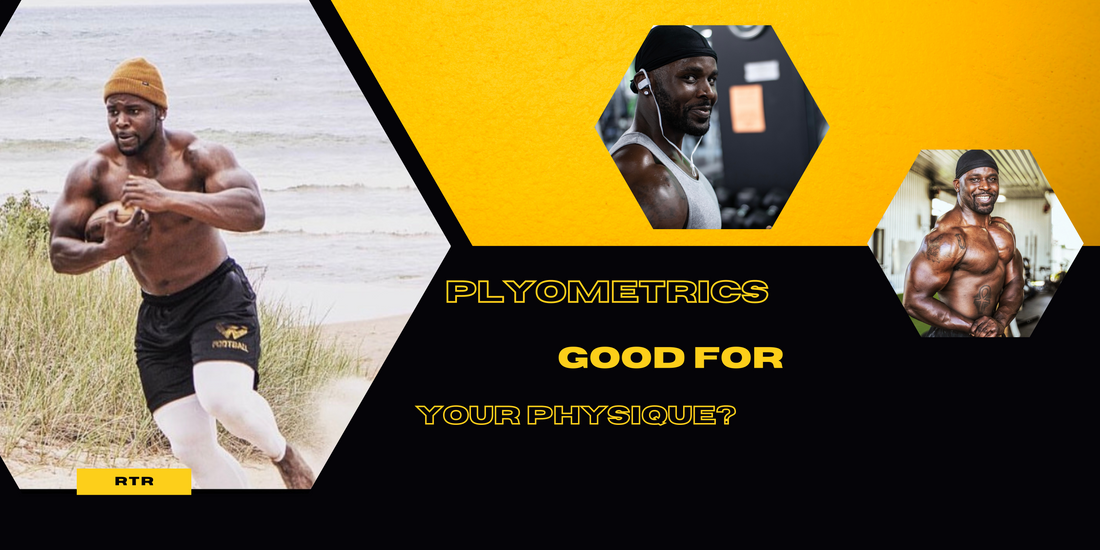| Exercises | Sets | Reps |
| Med Ball OH Toss | 3 | 5 |
| Pullups | 4 | 10 |
| Shoulder Press | 4 | 10 |
| Face Pull | 3 | 15 |
| Incline Press | 3 | 10 |
| Lateral Raise | 3 | 10 |
| V-Up's | 2 | 15 |

Plyometrics Good For Your Physique?
WHAT ARE PLYOMETRICS?
Most commonly associated with sports training, plyometrics also have a place in general population programming.. ESPECIALLY for those looking to improve their physique.
Plyometric training should be performed with quick, intentional movements utilizing a system of reactive exercises sequenced with an eccentric contraction, followed by an immediate explosive concentric contraction.
For the sake of this blog, we will focus on plyometrics and their potential to enhance your physique, but realize plyometrics are built upon various scientific principles (stretch-shortening cycle, optimizing sarcomere length, and stretch reflexes) that can help individuals tremendously boost their power output and enhance functional ability.
Along with the increased power output benefits, this style of training is also very beneficial in post-rehabilitation, and pre-habilitation (or injury reduction) protocols. Benefits include, but are not limited too:
● Improved control for varus and valgus (Caving in, Excessive bowing) movements at the knees during landing
● Enhanced dynamic knee stability during the deceleration phase of landing
● Enhanced anaerobic power and vertical jump height
● Improvement in overall power and change of direction speed in all planes of motion
Standards For Plyometrics
Textbook and other literature will typically recommend certain prerequisites before beginning any type of "power" or plyometric training in order to minimize injury risk.
Such criteria may be:
- Strength of squatting 1.5x bodyweight for lower body plyos
- Med Ball Throws for a particular distance (varies based on gender)
- Performing 5 clap pushups in succession
- Single leg stance for time with eyes closed/open
However, some of these may not be practical especially outside of the sports and performance realm. I recommend the user of this style of training understand:
-
FORM - Adequate form is key to all styles of training for injury prevention and maximal performance benefits.
-
PURPOSE - Doing movements just because you saw your favorite influencer perform it, or because you USED to do them back in the day is a sure-fire way to get hurt and or regress.
- INTENT - Especially with plyometrics intent has to be evident to reap the full benefits of the movements. If you're doing a broad jump really EXPLODE out, if its a med ball pass.. then throw it as if your LIFE depended on it.
Start Easy and Progress, Here is a beginner friendly plyometric:
Plyometrics And Physique
Plyometrics tend to preferentially hypertrophy Type 2 fibers which just so happen to also have the greatest capacity for strength and overall muscle definition compared to their counterparts the Type 1 fibers. You can see a real life example of how this applies in the sporting world when you look at a sprinter vs an endurance athletes physique (Sorry Cardio Queens).
If you do not feel like doing max effort jumps or throws, you can also opt for the more traditional route you see in most group classes around the world. Performing submaximal plyometrics in a circuit fashion is a guaranteed way to increase calorie burn and change up your typical routine, so long as programming is appropriate for the user(s).
OTHER BENEFITS OF PLYOMETRICS
At a later date I will go in depth on plyometrics and the many forms, but for now some other notable benefits of plyometric training, are:
● Increased vertical jump height
● Increased strength
● improved running speed, agility, and quickness
● injury reduction
● improved throwing, hitting, striking velocity
PLYOMETRICS During Warmups? Or?..
The beauty in plyometrics is that they can serve as a stand alone movement(s) for the entire workout, be implemented in the warmup to prep your nervous system and add some excitement before the main lifts of the day (My Recommendation), or be paired with your main lifts in a more advanced style of training (Later blog post).
Examples of upperbody and lower body plyos:
Monday
| Exercises | Sets | Reps |
| Box Jump | 3 | 3-5 |
| Back Squat | 5 | 5 |
| Romanian Deadlift | 3 | 10 |
| DB Step Up | 3 | 8-10 per side |
| Calf Raise | 3 | 25 |
| Hanging Leg Raise | 2 | 15 |
| Plank | 2 | 60 sec |
Tuesday
| Exercises | Sets | Reps |
| Banded Plyo Pushups | 3 | 5-8 |
| Bench Press | 5 | 5 |
| Barbell Row | 3 | 10 |
| Cable Fly | 3 | 15 |
| Tricep Push Down | 2 | 15 |
| Barbell Curl | 2 | 12 |
Thursday
| Exercises | Sets | Reps |
| Broad Jump | 3 | 3 |
| Deadlift | 5 | 3 |
| Leg Extension | 3 | 15 |
| Hamstring Curl | 3 | 12 |
| Tibialis Raises | 2 | 25 |
| Decline Crunches | 2 | 15 |
| Russian Twist | 2 | 20 |
Friday